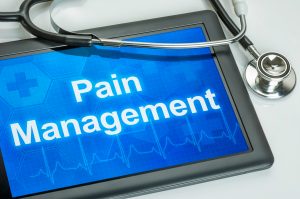There is no single approach with regard to the management of pain and the approach should be tailored to the identified cause. Probably the most important factor to consider is the potential for adverse affects arising from any analgesic medications, in particular, the potential to aggravate confusion or sedation. Please consult local pain management formulary and/or local pain management team for advice.
Depending on the type of pain, some of the following strategies may be indicated:
- Physical Approaches:
- Application of heat, cold, vibration, or massage – but in some situations avoidance of stimulation is the most appropriate approach.
- Physiotherapy interventions.
- Postural management.
- Acupuncture.
- Electrical stimulation (TENS).
- Orthotic supports.
- Pharmacological Approaches: The concept of “pain ladders” defines how one should escalate the approach when prescribing for pain. Most health authorities have specific formularies with which prescriber should be familiar. One should also be familiar with the drug side-effect profile, in particular side-effects relevant to brain injury. Typical rankings are as follows:
- Mechanical or inflammatory pain ladder:
- Topical agents (NSAID typically or consider Lidocaine, Capsaicin in patients for whom oral NSAIDs are contraindicated and to avoid sedative effects of opioids).
- Paracetamol.
- NSAID (assuming there are no contraindications).
- Mild opioids.
- Strong opioids.
- Antispasticity agents, where spasticity is a significant contributor to pain.
- Neuropathic pain ladder: these medications may also be appropriate in the management of brain injury related headache. The principle of use is that antidepressant or anticonvulsant medications, though designed to suppress transmission of nerve impulses along pathways that affect mood or seizure activity, they can have a similar effect on pain pathways. They typically do not have an adverse effect on mood but may have sedative side effects. Medications for treating Neuropathic pain include the following (if there is no benefit from medications listed in first three bullet points consult a pain specialist resource):
- Topical agents (Lidocaine).
- Tricyclic antidepressant (Amitriptyline, Imipramine, Nortriptyline).
- GABA Gamma-Aminobutyric Acid) analogues (Gabapentin / Pregabalin). These are anticonvulsant drugs, but have also been proven to be effective for as analgesic agents.
- SNRI antidepressant drugs (e.g. Duloxetine, Venlafaxine) and SSRI antidepressant drugs (e.g. Fluoxetine, Sertraline, Citalopram) may be helpful. SNRIs appear to be more effective. The impact may be partly in terms of modifying the emotional response to pain, rather than a direct analgesic effect.
- Other anticonvulsant drugs (e.g. carbamazepine, valproate, topirimate).
- Opioids are morphine-like drugs, which act at opioid receptors. The term opiates is sometimes used interchangeably, but this term strictly describes medications derived from the plant opium. They are frequently used in the early management of neuropathic pain because the therapeutic effect may be achieved more quickly, but this is typically associated with increased side effects. Therefore their initiation is usually followed by a gradual transition to other medications on the pain ladder.
- Nerve blocks can be considered in unresponsive situations, but may be associated with permanent function loss. However lidocaine nerve blocks, especially for shoulder subluxation has transient effect, and is often useful in shoulder subluxation pain.
- Mechanical or inflammatory pain ladder:
- Psychological Approaches:
- Explanation.
- Environmental changes.
- Relaxation approaches.
- Health behaviour change strategies.